Path to Sustainability is Gardens and Orchards – We’ve been talking about various steps along the path to sustainability.
That is, practices that will carry us over from year to year, even if our outside resources fail us.
Like sustainable production of livestock, ongoing success growing fruits, vegetables, and herbs depends on a few specific factors.
We can keep gardens and orchards going year after year without outside resources by establishing perennial plants, saving seeds for annuals, providing us a wellness sanctuary and providing an ongoing supply of good soil amendments.
On our farm we’ve started using all of these methods and we’re learning more and more about them each year.
We’re still buying trees, plants, and seeds, but we feel that we have a good start on being sustainable with our gardens and orchard.
Path to Sustainability is Gardens and Orchards
Most orchard trees and bushes are perennials — plants that live for years without reseeding or replanting.
There are also a number of perennial garden vegetable plants that will keep on producing for many years. Hugelkultur Gardening
Some require nothing more than mulching, while others depend on pruning for healthy growth year after year.
Fruit and nut trees
Can be planted as saplings of varying sizes.
The larger the sapling, the faster the tree will become established and the sooner it will bear a substantial amount of fruit.
There are some tricks to planting fruit trees, including attention to planting season, protection from animal browse, and watering.
Pruning from year to year is also important.
Berry bushes and grape vines
Are perennial, and usually produce sooner after planting than fruit and nut trees.
Most bramble bushes and grape vines grow best with support, ample water during establishment, and some pruning.
An excellent source of information on growing fruits, nuts, berries, and grapes is The Fruit Gardener’s Bible by Lewis Hill.
Also see Planting and Caring for Fruit Trees at Sunset Magazine and Growing Berries in Your Backyard at Mother Earth News.
Garden perennials
Including asparagus, rhubarb, lovage, and Jerusalem artichokes will also produce for many years.
A number of herbs including sage and rosemary are perennials in some or all climates.
Most perennial vegetables and herbs are planted once and just maintained, while others such as asparagus need some special attention for the first few years.
Some perennial vegetables with spreading root systems–like rhubarb–can be propagated by root division, while other plants including some perennial herbs adapt well to rooting of stem cuttings.
This way you can increase the number of plants for yourself or to share, and replace weak plants with more vigorous young plants.
Generally, plants that yield in spring and summer are best divided in fall so the root systems will be well established by spring.
Allium (garlic, chives) heads may be divided in fall; each planted clove has the potential to grow a new plant the following summer.
A super introduction is a Perennial Vegetables: Grow More Food With Less Work at Mother Earth News.
Author Eric Toensmeier has included 100 perennial vegetables in his book Perennial Vegetables.
Tools of the trade
Part of preparing for sustainable food production is amassing all the tools and equipment you might need.
This can range from small hand garden tools (great pruning shears review) to larger pieces of equipment to tractors and other vehicles, fuel to operate them, and the means to repair them.
One way to get a good idea of what you’ll need is to take notes for an entire year:
what you use, how you use it, how to keep it in good repair.
Then gradually add to your collection of tools and equipment.
Easiest Vegetables to Grow: A Simple Garden Guide
Building a Raised Garden Bed Cheaply
Saving seeds for annuals
Most vegetables must be planted each year, and that requires viable seeds.
Today, vegetable seeds may be purchased in many local retail establishments from grocery stores to big box stores to garden shops and nurseries.
There are also many online sources of garden seeds.
One day, it may not be so easy to find seeds.
And frankly, many of us would like to cut the cost of seeds now anyway.
Saving seeds from garden production is fairly simple and yields good results with a supply of seeds for the following year…at no cost!
There are a few tricks to saving seeds, and some basic understanding of plant varieties is helpful.
First of all, there are several ways to collect seeds, depending on the type of plant.
Secondly, common hybrid plants yield seeds that are not reliable for consistent reproduction, so it’s important to save seeds from heirloom plants.
Collecting seeds
Can be as simple as pulling seeds off a mature plant or a bit more complicated, like removing seeds from a pepper or bean pod.
Some seeds are ready for saving right off the plant, while others, such as tomato seeds, must be soaked or otherwise treated.
Learn more at Saving Seed from the Garden and Seed Saving Tips.
Hybrid vs. heirloom
Do you know the difference? Hybrid plants are developed for increased stamina, production, or eye appeal.
However, their seeds do not produce consistently, and a gardener could end up with weak or fruitless plants, odd produce, and other unexpected results.
Heirloom plants reproduce plants and fruits like the parent plant; in other words, you know what you’ll get at harvest time.
Open pollinated?
Books and online resources have caused confusion over the definition of the term “open pollination.”
Some sources consider heirloom seeds equivalent to open pollinated seeds.
Others define open pollination as natural pollination by insects, wind, etc. as opposed to self-pollination of plants.
In any case, if you plan to save seeds, it’s important to avoid cross-pollination of heirloom plants by planting different varieties far enough apart.
Seeds can be collected from regular garden rows or patches or from a specified seed saving bed
Designating an area just for saving seeds may make it easier to reserve seeds from each plant and also allow for full maturity of those plants that go to seed late in the season.
Just plant one or two of each vegetable in the seed saving bed and make sure no one harvests the produce for the kitchen.
Another type of “seed”
Is actually the fruit of a plant. You can save small potatoes to plant next year and garlic cloves to plant in the fall.
Store in a cool, dry location.
Sprouting during storage does not necessarily render them useless; sprouting potatoes and garlic can still be planted.
Storing seeds
Properly is also important. Seeds should be stored in dry containers in a cool, dry location.
Too much moisture, heat or freezing can damage or kill some seeds.
A warm, moist environment can invite premature germination during the fall or winter, and the sprouts will die before planting time.
That means less seed for the gardening season.
Read more about seed saving at Seed Savers and at Mother Earth News.
Starting seeds
Can be as simple as pressing beans into the soil and waiting.
Or a little more time-consuming, like planting tomato seeds indoors and nurturing small seedlings till they’re ready to go out to the garden.
Just for fun, to save money, or to provide for yourself when you can’t find seedlings to buy, you can be prepared to raise your own seedlings with an assortment of seed starting containers, heat mats, lights, grow racks, and perhaps even a cold frame or greenhouse.
Providing soil amendments
We have three words to say about this: compost, compost, compost!
One of the basic ways to create a rich soil amendment is to compost waste products from the kitchen and yard.
Added to the garden from year to year, compost will improve the texture of your garden soil while contributing food for your plants.
Large quantities of compost can be spread over the entire garden bed; if your supply is smaller, compost can be added directly to planting holes.
Compost tea is simple to make and a great way to spot-feed individual plants.
We encourage everyone to learn how to compost and use as much of their household, garden, backyard, and barnyard waste as they can.
While simply piling materials will yield some sort of compost, it’s far better to mix materials for a balance of carbon and nitrogen inputs.
This is a science, but it can be simplified.
Canine, feline, and human feces and urine should not be used in a compost pile intended for food production use.
Aside from compost, there are other efficient ways to provide nutrients to your garden and orchard.
If your soil is lacking specific nutrients
There are ways to add them, too.
A simple soil analysis will tell you about the composition of your soil.
Then you can supplement your compost with specific materials such as egg shells for calcium or banana peels for potassium.
Find some ideas at Ten Natural Fertilizer Recipes from Home Grown Fun.
Livestock manure
Valuable additive to the garden.
If you have access to large amounts of livestock manure from your own place or a neighbor, this can add bulk and nutrients to the compost you create from your own home and yard waste.
Another form, DIY manure tea, is valuable for individual plant feeding.
Green manures
Can also be planted to improve garden soil during fallow months. While often used in large agricultural fields, green manure crops are also very effective in small home garden plots.
Ask your local extension or agriculture agent about the preferred green manure plants for your area.
Mulching
With deciduous leaves, evergreen needles, straw, and other materials helps plants and trees throughout the year.
Mulches help retain moisture and proper temperature while adding nutrients to the soil as they decompose.
Be aware that some materials such as evergreen needles may contribute too much acid or other element for certain plants.
And don’t forget that most vegetable garden plants and orchard trees need water
If you’re in a climate with dry phases and are on a public water system or rely on electricity to run a well pump, consider a rain catchment system or another source of water for your garden and orchard.
Food for other senses
Vegetable gardens and orchards provide a feast for the taste buds. But don’t forget about enjoyment for the eyes and noses as well!
All of the concepts mentioned above are also effective with flower gardens and landscaped areas. In closing, just a warning: Raising your own food can become addictive!
Enjoy the path to sustainable food production!
Please add your ideas for garden and orchard sustainability in the comments section.
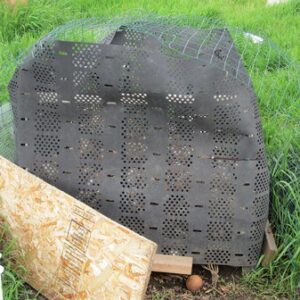
The problem of Building a Compost Pile
We’ve had a compost problem…but we’ve found a compost solution.
Our compost pile was started two years ago in a location that has now become the middle of a through-way in our garden area.
Our two wonderful dogs, our chickens, and the local magpies can’t seem to resist the buffet.
You’ll see why we want a better setup when you look at this picture of our scrappy patchy system that temporarily protects the pile from dogs that dig at ground level and birds that land right on the pile.
The solution Building a Compost Pile
We decided to move the compost pile, fence it in with wood pallets, and cover it with a screened lid.
Just when we were getting our plans in gear, we started reading about Compost-Along.
We decided to join the party, exchange experiences with other composters, and learn some new composting tips along the way.
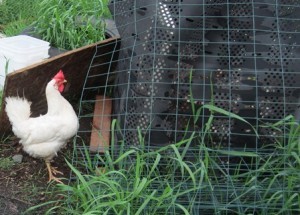
Our existing compost system
A few years ago I attended a local compost fair and received two of the cool rigid plastic compost bins seen in the photos above.
They’re tall, adjustable, and well-ventilated. Normally they even stand up straight.
I have composted in these bins for two years now.
We put in all our kitchen and garden food waste that the chickens don’t get, including coffee grounds/filters, paper scraps, onions, citrus, and raw potato peelings.
Once in a while we rake up stalks, rinds, and other leftovers from the chicken pen.
We’ve added garden weeds that have not gone to seed, as well as various leaves and other vegetation we have.
We planted red worms in the pile to speed up decomposition.
Earthworms can also enter the pile from the dirt floor.
We avoid putting meat or animal manure in this pile, as we want it to create compost safe for all our food crops.
We’ve never been sure how hot our pile gets and how many microorganisms might remain in the compost.
So we either put the chicken coop litter directly on the garden in the fall or compost it in a different pile.
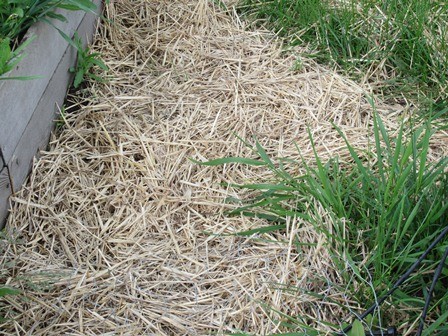
Composting along
Our Compost-Along project will be our kitchen/garden scrap compost pile.
We got busy planting our garden and thoughts of composting were set aside for a time…so today we’ll cover weeks 1 and 2.
- Decide on a type of compost bin.
- Decide how to get compost ingredients.
- For extra credit, get a bin and start collecting compost materials.
We’ll use our plastic bins enclosed by wood pallets, with potential to have two piles going at the same time.
We’ll continue to use our kitchen and garden scraps, and will collect more ingredients like leaves, sawdust, wood ashes, straw, and grass clippings around the farm.
We also got some new ideas from the LHITS compost ingredients list: dryer lint and dog hair!
At times we have an abundance of both around here.
Extra credit: We already have the bin and some materials to compost.
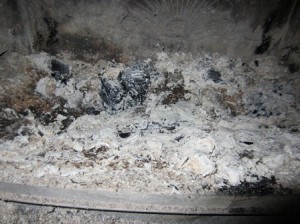
Week 2 Composting
Get or make a bin.
Collect compost materials.
For extra credit, gather up some natural compost activators, like alfalfa meal, blood or bone meal, cottonseed meal, fish emulsion, comfrey, stale dog food, seaweed, and urine.
Composting results
We have an empty bin, though we haven’t yet made the wood pallet frame.
We have a few buckets containing kitchen scraps, yard clippings, wood ashes, dryer lint, and dog hair.
Ready to roll when we hear “Ready, Set, Go!”
I learned something new this week too: I didn’t know about all those compost activators!
I’ll plant some comfrey this year and collect any dog food that might go stale.
Extra credit: We have fish emulsion, which we use as a garden fertilizer.
Should we just pour some in the compost pile?
Related Contents:
- Pepino Melon ~ Eating and Growing These Tasty Melons
- Growing Tomatoes in Pots and Containers
- 10 Ways to Make Your Garden Look Beautiful
- No-till Gardening: Your Complete Guide to An Easier Way to Grow
- The Path to Sustainability: Preparing and Preserving Fresh Foods
- 80 Acres Farms Automated Indoor Farm
- Types of Oranges | What Varieties Are Best for Homesteading?

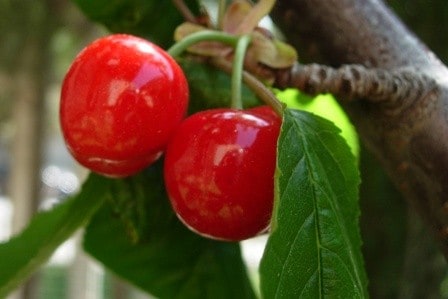
I’m loving this series! Thanks for sharing on Wildcrafting Wednesday!